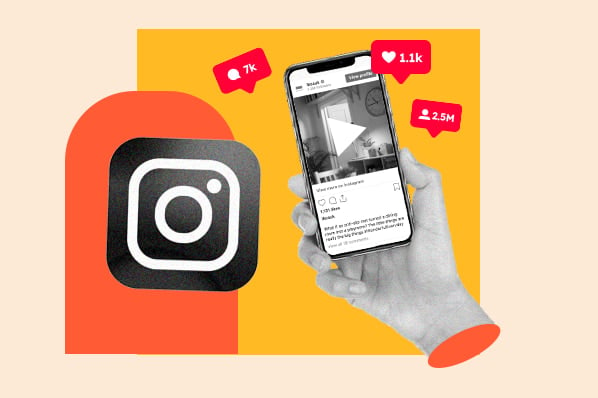Let's take a closer look at the key differences between YouTube and TikTok — and how to choose the right platform for your business.
YouTube vs. TikTok: A Head-to-Head Comparison
1. Demographics.
YouTube
With a global user base of more than 2 billion people, it's safe to assume that your target audience is on YouTube. Let's take a closer look at its user base.
YouTube holds sway with both men and women, almost in equal measure. Male users account for 53% of its population, while female users account for 46%.
The platform is also popular across different age groups. Outside of China, 77% of Gen Z, 75% of millennials, and 44% of Baby Boomers visit YouTube daily. Specifically, the 18-25 year age group commands the largest visitor base.
YouTube attracts a global audience, with more than 95% of the internet population using it. That said, India accounts for the largest audience size, followed by the United States and Indonesia.
TikTok
TikTok is known as the platform for Gen-Z — and the stats confirm it. Over half of Gen-Z consumers are on TikTok, and 46% of 13-19-year-olds say they use the platform daily.
However, TikTok is also picking up steam with other age groups. In 2021, 36% of TikTok users were between 35 and 54 years old, a 10% increase from the year before.
Unlike Youtube, TikTok's user base skews primarily female (57% worldwide). That figure jumps to 61% for TikTok users in the US. While TikTok's user base is increasingly diverse, there's no denying its popularity among younger female audiences.
TikTok is a global platform available in 154 countries worldwide and in 75 different languages. The United States accounts for the largest user base (120 million users), followed by Indonesia, Brazil, and Russia.
2. Popularity.
There's no real competition here (yet). YouTube commands an audience of over two billion monthly users — almost half of the entire internet-using population. It's no surprise that one in five social media marketers plans to invest the most in YouTube this year, according to a recent HubSpot Blog's report.
 However, TikTok is a relatively new platform with stellar growth year-over-year. TikTok was the most downloaded app in 2019 and 2020, racking up over three billion downloads so far. It also boasts 1.2 billion monthly users, which experts predict will reach 1.5 billion by the end of 2022 — keeping YouTube on its toes.
However, TikTok is a relatively new platform with stellar growth year-over-year. TikTok was the most downloaded app in 2019 and 2020, racking up over three billion downloads so far. It also boasts 1.2 billion monthly users, which experts predict will reach 1.5 billion by the end of 2022 — keeping YouTube on its toes.
Additionally, while TikTok doesn't bring in the same monthly users, it certainly wins at engagement. In fact, TikTok is the most engaging of all social media apps, with an average user session of 10.85 minutes. As a result, 52% of marketers who use TikTok plan to increase their investment in 2022.
 3. Content Format and Length
3. Content Format and Length
YouTube
Unlike other social media platforms, YouTube has become the unofficial home for long-form content. For instance, you've likely stumbled upon a 30-minute workout video or even a 2-hour podcast on YouTube.
However, it's impossible to deny the popularity of short-form video content. In fact, 31% of marketers are currently leveraging short-form video, and 29% plan to leverage it for the first time this year.
 In response, YouTube launched Shorts — enabling users to create 15-second videos with musical overlays. This also allows video marketers to play with different content types on the same platform.
In response, YouTube launched Shorts — enabling users to create 15-second videos with musical overlays. This also allows video marketers to play with different content types on the same platform.
TikTok
To put it plainly, TikTok is a short-form powerhouse. In fact, the app has become synonymous with fun, "snackable" content that attracts Gen-Z and millennial audiences.
Why does this matter? Short-form video is the most popular and effective social media format in 2022. So much so that 50% of social media marketers plan to leverage short-form video for the first time this year, and 95% of those who already use it will increase or maintain their investment.
Initially, TikTok videos could only be 15-seconds long. However, the app has extended the limit to 60 seconds. For marketers, this means more wiggle room to play around with video concepts. However, this only applies to videos recorded natively on the app.
4. Ad Formats
YouTube
YouTube ads are powered by Google. You have several ad formats to choose from, including:
- Discover ads — ads that appear on the YouTube homepage or search results pages.
- TrueView ads — also known as skippable ads, these are ads that play before a video.
- Non-skippable ads — ads that appear before, in the middle, or after a video.
- Bumper ads — 6-second ads that play before a video.
- Overlay ads — banner ads that appear at the bottom of a video.
YouTube offers a lot of flexibility for marketers to experiment with different ad formats. For example, you can opt for a quick, 6-second ad at the beginning of a video or a 30-second non-skippable ad in the middle of a video.
TikTok
Despite its "newness," TikTok has become a viable option for brands willing to get creative with their digital marketing. So much so, it launched TikTok for Business in 2021, allowing marketers to create and manage ad campaigns on the platform.
Additionally, there are different ways to advertise on the platform, including:
- TopView — ads that appear at the top of their feed immediately after opening the app.
- In-Feed Ads — ads that appear on a user's discovery page.
- Branded Hashtags — a hashtag that businesses promote in hopes of inspiring TikTokers to create content around it.
- Brand Takeovers — an ad format that can include TopView, In-Feed, and Branded Hashtags all at once. They can also be videos, gifs, or still images.
As we'll discuss later, each ad format on TikTok has a different price tag — so even if you have a smaller budget, you can play your cards right with a solid strategy.
5. Ad Costs
YouTube
YouTube follows a cost-per-view pricing model. Each view can cost between $0.10 and $0.30, depending on your industry and target keywords. You only pay when a user takes action — such as watching the entirety of your ad or clicking on a call-to-action.
You can spend as little or as much as you want. However, most businesses invest $10 or more a day to run an advertising campaign on YouTube. If you set a daily budget, Google will only charge you up until that amount, making YouTube ads a relatively safe investment.
TikTok
If you decide to advertise on TikTok, you can select a daily or lifetime budget that can be adjusted at any point during your campaign. However, at the campaign level, you must have a minimum daily and total budget of $50. For an ad group level, your budget must exceed $20 daily.
It's also important to note that TikTok doesn't use cost-per-click as a metric. Instead, it uses cost-per-mille (CPM), which means cost per 1000 views. TikTok ads start at $10 per CPM, so it's possible to make an impact at a relatively low cost.
Which platform is right for your business?
One final question remains — which platform is better for my business? Ultimately, the answer hinges on several factors.
First, who is your target audience? As you can see, both YouTube and TikTok boast diverse audiences, but TikTok commands a younger, predominantly female audience. YouTube, on the other hand, is popular across multiple age groups. To state the obvious, you should prioritize the platform that will reach your audience.
Second, what type of content do you want to make? Does it lend itself more to lighthearted, snappy videos or longer, more in-depth ones? Is 15 seconds long enough to convey your message, or do you need more time?
Lastly, it's important to consider your budget. YouTube offers more flexibility in choosing a daily budget. And, since it follows a cost-per-view pricing model, you only pay when a user takes action. To run a campaign on TikTok, you must commit to a daily budget of $50, which quickly adds up.
With these questions in mind, you have a better idea of which platform is right for your business. But remember, marketing is all about experimentation. You don't need to commit to one platform right away — in fact, it may be useful to run side experiments on both to see what results you get.
Video Marketing





![The best social media platforms for video content in 2025 [consumer data]](https://53.fs1.hubspotusercontent-na1.net/hubfs/53/img-1-20250516-9399498.webp)


![3 Short-Form Video Trends Marketers Should Watch in 2025 [New Data]](https://53.fs1.hubspotusercontent-na1.net/hubfs/53/ft-short-form-video-trends.webp)
![Are In-Stream Video Ads Worth the Investment? [Benefits & Best Practices for Marketers]](https://53.fs1.hubspotusercontent-na1.net/hubfs/53/in-stream-video-ads-1-20250314-6407067.webp)
![45 Video Marketing Statistics for 2025 [New Data]](https://53.fs1.hubspotusercontent-na1.net/hubfs/53/video-marketing-statistics-1-20250227-6425117.webp)
![Why You Should Leverage Interactive Videos [Data from 500+ Marketers]](https://53.fs1.hubspotusercontent-na1.net/hubfs/53/interactive-video-1-20250216-406926.webp)
![Silent But Mighty: How Soundless Videos Are Winning Social Media [+ 2025 Data]](https://53.fs1.hubspotusercontent-na1.net/hubfs/53/Soundless%20Videos%20We%20Love.png)